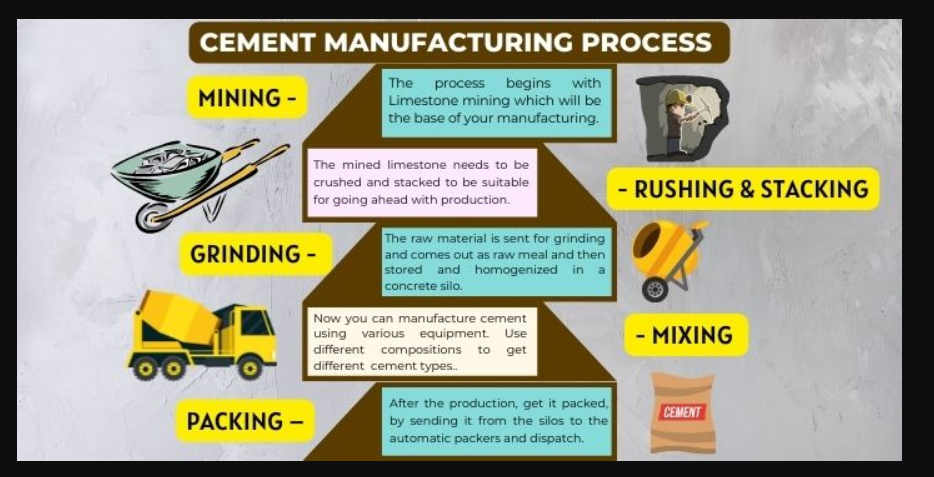Contents
How to Start a Cement Factory: A Comprehensive Guide

TO Download this post and all the books and excel sheets and my personal notes and presentations I collected about cement industry in the last 30 years click the below paypal link
Executive Summary
- Introduction to the Cement Industry
- Purpose and Scope of the Report
- Key Findings and Recommendations
Chapter 1: Industry Overview
- History of the Cement Industry
- Current Global Cement Market
- Key Players in the Industry
- Future Trends and Forecasts
Chapter 2: Understanding Cement
- Composition and Types of Cement
- Raw Materials Required for Cement Production
- Cement Manufacturing Process
- Mining and Preparation of Raw Materials
- Raw Material Grinding
- Preheating and Precalcining
- Clinker Production
- Cement Grinding
- Packaging and Distribution
Chapter 3: Market Research and Feasibility Study
- Market Analysis
- Target Market Identification
- Market Demand and Supply Analysis
- Competitor Analysis
- Feasibility Study
- Technical Feasibility
- Financial Feasibility
- Operational Feasibility
Chapter 4: Business Plan Development
- Executive Summary
- Company Description
- Market Strategy
- Marketing Plan
- Sales Strategy
- Organization and Management
- Organizational Structure
- Management Team
- Product Line or Services
- Financial Plan
- Start-up Costs
- Funding Requirements
- Financial Projections
- Appendices
Chapter 5: Location and Site Selection
- Factors Influencing Site Selection
- Proximity to Raw Materials
- Transportation Access
- Utilities and Infrastructure
- Environmental Considerations
- Site Acquisition Process
- Land Acquisition
- Zoning and Land Use Regulations
- Environmental Impact Assessment
Chapter 6: Regulatory and Legal Framework
- Permits and Licenses Required
- Environmental Regulations
- Health and Safety Standards
- Industry-Specific Legal Considerations
Chapter 7: Plant Design and Layout
- Plant Design Principles
- Layout Planning
- Raw Material Storage
- Processing Areas
- Finished Goods Storage
- Auxiliary Facilities
- Equipment and Machinery Selection
- Utilities and Support Infrastructure
- Power Supply
- Water Supply
- Waste Management
Chapter 8: Construction and Commissioning
- Project Planning and Management
- Construction Phases
- Site Preparation
- Civil Works
- Equipment Installation
- Commissioning and Start-up
- Testing and Quality Assurance
- Staff Training and Development
Chapter 9: Raw Material Procurement and Handling
- Raw Material Sources and Suppliers
- Quality Control and Testing
- Logistics and Transportation
- Storage and Handling
Chapter 10: Production Process and Technology
- Detailed Process Flow
- Technology Options and Innovations
- Energy Efficiency and Sustainability Practices
- Quality Control and Assurance
Chapter 11: Workforce and Human Resources
- Workforce Requirements
- Skilled vs. Unskilled Labor
- Recruitment and Training
- Labor Laws and Regulations
- Employee Health and Safety
Chapter 12: Marketing and Sales Strategy
- Branding and Positioning
- Marketing Channels and Strategies
- Pricing Strategies
- Distribution Channels
- Customer Relationship Management
Chapter 13: Financial Planning and Management
- Capital Investment and Financing Options
- Cost Analysis and Budgeting
- Revenue Projections
- Financial Risk Management
- Break-even Analysis
- Financial Reporting and Performance Metrics
Chapter 14: Risk Management
- Identification of Potential Risks
- Risk Assessment and Mitigation Strategies
- Contingency Planning
- Insurance Requirements
Chapter 15: Environmental and Social Responsibility
- Environmental Impact Mitigation
- Emission Control
- Waste Management
- Community Engagement and Development
- Sustainable Practices and Innovations
Chapter 16: Information Technology and Automation
- IT Infrastructure in Cement Manufacturing
- Automation and Smart Manufacturing
- Data Management and Analytics
- Cybersecurity Considerations
Chapter 17: Case Studies and Best Practices
- Successful Cement Factories
- Lessons Learned from Failures
- Industry Best Practices
Chapter 18: Future Outlook and Innovations
- Emerging Technologies in Cement Manufacturing
- Trends Shaping the Future of the Industry
- Strategic Recommendations for New Entrants
Chapter 19: Appendices
- Glossary of Terms
- List of Abbreviations
- Additional Resources and References
- Sample Business Plan Templates
- Contact Information for Key Industry Bodies

It is very useful.Many thinks.Cement subject is very wide.
It give many knowledges and for my worksite.(cement plant.)